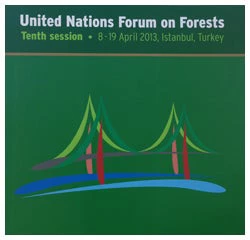
"The global threats which humanity faces eliminate the luxury of saying, ‘What do I care?’” Erdoğan said. “We are not only creatures of bodies, heads, and brains. We carry hearts, we carry souls, and we carry a conscience.”
So what did the UN Forum accomplish after days of discussions and negotiations? Did the Forum rise to Erdoğan's challenge?
In a word, “yes,” though one could be forgiven if this was not immediately obvious. The slow convergence of views in these types of negotiations, where bracketed text eventually gives way to clearer insights and concrete action is not always easily evident.
But UNFF10 concluded with two resolutions: one laying out a plan for how forests will be handled in the post-2015 development agenda; and the other calling on UN member states to better integrate forests in their economic development strategies, in part by better accounting for the goods and services forests provide and developing more coherent policies so that growth does not come at the expense of forests.
I suppose this doesn’t sound Earth-shattering, but the power of these resolutions is that they provide validation for our own work on things like WAVES and natural capital accounting and give governments the tools to encourage bureaucrats and politicians alike to take clearer action to support forest conservation and management.
There is still progress to be made. Notably absent from any of the resolutions were extensive references to tackling challenges of sustainable forests management from a landscapes perspective, partly because the concept is not well defined or widely understood. One of the two final resolutions encouraged the adoption of cross-sectoral approaches toward sustainable forest management "at a landscape level in countries that recognize it."
At side events, however, the idea that forests are part of a broader physical and economic landscape that goes beyond the purview of state forest agencies met little resistance:
- A side-event in which I participated, together with representatives from the Governments of Mexico and Ghana, CIFOR, the World Bank, and IUCN (representing the Global Partnership on Forest Landscape Restoration (GPFLR), highlighted the development of tools and approaches for exploiting the potential for landscape restoration through cross sectoral and cross-institutional collaboration.
- Institutionally, the landscape is also expanding and shifting. A side event on investing in locally controlled forestry argued for enabling local communities to access markets, finance and technology so they can participate as co-investors rather than collateral benefit-recipients in a rapidly growing forest private sector.
- Another side event on good business, making private investment work for forests, reiterated the fact that private financial flows to forests now vastly outstrip public ones (9 to 1), and that the bulk of these have been going to Latin America for plantation development. That said, the extent of domestic private investment in the forest sector in developing countries is poorly understood, partly because so much of it happens informally. This lack of data is a complicating factor as countries struggle to design green growth plans that reconcile competing economic and environmental needs on the same plots of land. But one that member development partners ought to tackle together, as requested explicitly in one of the Forum resolutions.


Join the Conversation